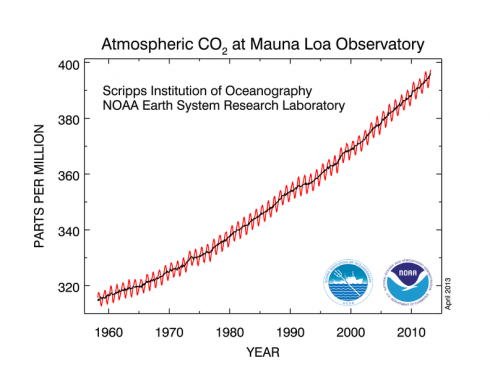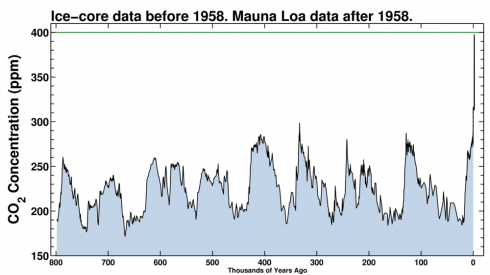Why I’m Marking Passing 400 ppm By Getting Back On An Aeroplane
By Rob Hopkins
16 May, 2013
Transition Culture
In November 2006, I sat at the back of the Barn Cinema, Dartington, and watched ‘An Inconvenient Truth‘. It had such an impact on me that by the time it ended, I had decided that I couldn’t just leave the cinema without marking the event by making some kind of change in my life. I decided that evening not to fly again, and I haven’t flown since. I have played an active part in supporting the growth of an international movement in 40 countries since then, participating in countless workshops, and discussing Transition internationally through Skype and pre-recorded talks, most of which I begin with how much carbon I have saved by not travelling in person. However, I recently watched the film ‘Chasing Ice’, and it had, if anything, a more visceral impact than ‘An Inconvenient Truth’. My resolution at the end of watching it, re-enforced by the recent passing, for the first time, of 400 ppm of C02 in the atmosphere, was that it was time to get back on a plane, and I want to use this post to tell you why.
When I was born, the atmospheric concentration of CO2 in the Earth’s atmosphere was 325.36 ppm. I was 19 when it passed 350 ppm for the first time, the level which climate scientists such as James Hansen argue is the highest concentration possible if we are to “preserve a planet similar to that on which civilization developed and to which life on Earth is adapted” When, in 2004, the first seeds of Transition were sown when I sat with my students in a classroom at Kinsale Further Education College to watch The End of Suburbia, we were at 376.15 ppm. On the day this blog first began with its first post, we were at 378.29 ppm.
When I watched ‘An Inconvenient Truth’, it was 380.18 parts per million (ppm). On the day Transition Network was formally established we had reached 386.40 ppm. On the day I left Venice last September, following the Degrowth conference (which I had travelled to by train), seeing Venice from the sea as this extraordinary jewel just inches above sea level, concentrations had reached 391.06ppm. When I sat down to watch ‘Chasing Ice’ it was 395.55 ppm.

The rise in atmospheric CO2 concentrations during my lifetime (http://www.esrl.noaa.gov/gmd/ccgg/trends/#mlo_data).
A couple of weeks ago we passed, for the first time, 400 ppm. It’s just a number, but it had a deep impact on me, a sobering line in the sand, a deeply troubling face. As Joe Romm at Climate Progress puts it:
Certainly as we hit 400 parts per million (ppm) for the first time in human existence, with not even a plan to avoid 600 ppm, 800 ppm, and then 1000 — not even a national discussion or an outcry by the so-called intelligentsia – it is worth asking, why? Is there something inherent in homo “sapiens” that makes us oblivious to the obvious?
This means that current levels of CO2 in the atmosphere are far higher than they have been for the last 4.5 millions years at least. The graph below shows how concentrations have fluctuated over the past 800,000 years. By way of context, 30,000 years ago, Cro-Magnon man was flourishing, hunting and gathering and painting cave walls. The Guardian have created a great infographic that tells the story of 400 ppm and what it means in a very understandable way. As Damien Carrington in The Guardian puts “the last time so much greenhouse gas was in the air was several million years ago, when the Arctic was ice-free, savannah spread across the Sahara desert and sea level was up to 40 metres higher than today”.
In spite of all the efforts of the green movement, Transition initiatives, a slew of international conferences and meaningless agreements, the rise has continued inexorably. It shows little sign of slowing, the International Energy Agency warning last year that the world is on track for at least a 6 degree rise in temperatures by 2100.

Carbon dioxide concentrations for the last 800,000 years (http://keelingcurve.ucsd.edu/)
I know anecdotally that my giving up flying has inspired quite a few people to do the same, but has it had any impact at all on the rising levels of emissions? Clearly not. But has it been the right thing, thus far, to have done? Absolutely. A fascinating paper by Joakim Sandberg, called My emissions make no difference explored this question. He writes:
My suggestion is that we have a collective obligation to change our ways, and this collective obligation may be partly separate from the obligations of individuals. While my own flying makes no difference, it should be noted, climate change could be averted if we all changed our ways. But then it seems plausible to say that we act wrongly as a collective, even though no individual driver or flyer may be doing anything wrong. This view could be further explained by saying that moral questions can be asked on at least two different levels, with implicit reference to different sorts of agents. It is one thing to ask “What should I do?” but quite a different thing to ask “What should we do?” and the answers may not always converge.
The fact is that at a time in history when we desperately need to cut emissions sharply, we all have a responsibility to re-evaluate behaviour we undertake that normalises, for those around us, ways of acting that generate high levels of emissions. As Sandberg puts it, “while it may not typically be wrong of me to drive or fly, then, it may be wrong of us to do so and we must therefore seek ways of coordinating our environmental efforts more effectively”. I will still not fly for holidays or family reasons, to conferences, for pretty much any reasons. However I have decided, through discussions with those I work with, that passing 400 ppm, the extent of the climate crisis, means that it is time to get back on a plane, in cases where the benefits can be seen as outweighing the impacts.
Around 25% of the world’s emissions come from the US, the world’s greatest emitter of carbon dioxide. I recently had a moving conversation with someone in the US, who works for an organisation who fund groups acting on climate change, and who is very well connected politically in the US. She told me, with strong emotion in her voice, that it was her sense from talking to people she knows in the UN and other organisations, that there seems to be a consensus to give it another 18 months, 2 years at most, and then the funding and political effort will shift from mitigation and into adaptation and defence.
I’ll say that again. The funding and political effort will shift from mitigation and into adaptation and defence. Or to put it another way, that they will give up. The consensus will shift to the assumption being that it is now too late. Officially. The imminent White House briefing about the state of the Arctic ice and its implications probably won’t help either, given the gravity and seeming irreversibility of that situation.
I refuse to accept that the lurch to 500ppm, 600ppm, 800ppm is an inevitability. I refuse to accept, as Nigel Lawson tried to argue in his debate with the remarkably patient Kevin Anderson on Jeremy Vine’s radio show recently, that doing anything about climate change would impact on economic growth so we shouldn’t bother. I refuse to agree with Peter Lilley that the only way to preserve our economy is to allow unfettered gas fracking anywhere the gas industry decides it wants to drill because “there are simply no affordable renewable technologies available to replace fossil fuels”. I refuse to accept that we can’t do any better than what we have now, and that communities have only a passive role to play in doing something about this with the real work being done by governments and business. I refuse to give up while there’s still a chance.
So when an explicitly personal invitation came in to speak to a gathering of the largest philanthropic funders at their gathering in the US, and the opportunity to present them with Transition’s model of bottom-up, community-led action and to explain how Transition is increasingly focusing on the creation of a new economy, owned by the people, for the benefit of the people, the climate and the future, I had to think twice. That’s quite an extraordinary opportunity to try and influence the mindset of people who have the power and capacity to significantly support communities, and other crucial actors, who need to act to make the real and rapid shift so needed. I have thought long and hard about it.
I have come to a place, also through discussions with other people here at Transition Network and in discussion with our friends at Transition US and Post Carbon Institute, of feeling that it is worth having a go and getting on a plane and making the journey, in the (possibly naive) hope that it might sow some seeds of a new direction in the minds of some of the US’s foremost funders, give Transition in the US a boost, raise its profile, do what I can to try and support what’s already happening there. I would expect to return home wrung out like a sponge. This doesn’t open the door to now flying here, there and everywhere. This is a very particular invitation that has been looked at entirely on its own merits.
What do I know? Many of the movements, ideas, people and projects that have inspired me over the last 20 years have come from the US. There are wonderful things happening there, inspirational projects, great movements, incredible networks. But if Transition can bring something energising, some insights from this 7-year global experiment, some kind of renewed optimism that change is possible, something, anything, then it feels worth doing, before the window of possibility closes.
What haunts me every day, and no doubt will for the rest of my days, is what I will reply to my grandchildren when they ask me what I did during the time when climate change could have been brought under some sort of control, when the necessary changes could have been put in place to create a low-carbon, resilient and thriving culture that nurtured healthy human cultures. Was I as effective as I could have been? Did I do everything I could have? Having reflected on this for some time, it feels churlish to decline an opportunity that could potentially have a far greater positive impact than the negative impact of the flight.
So sometime in late September, it looks very much as though I will make that journey. Quite what I’ll do when I’m there has yet to be agreed (although we will of course let you know). Whether it will have any meaningful impact is even less certain. But it needs to be done, so I’m doing it.
The CO2 concentration statistics come from the Earth System Research Laboratory’s website, from measurements taken at the Mauna Loa research station.
Rob Hopkins is the co-founder of Transition Town Totnes and of the Transition Network.
Comments are moderated


